Nargis
Nargis Dutt[3][4] (born Fatima Rashid; 1 June 1929 – 3 May 1981) was an Indian film actress, who starred in classic films of Bollywood. Regarded as one of the greatest actresses in the history of Hindi cinema, she made her screen debut in a minor role at the age of 5 with Talash-E-Haq (1935), but her acting career actually began with the film Tamanna (1942).
Nargis Dutt | |
|---|---|
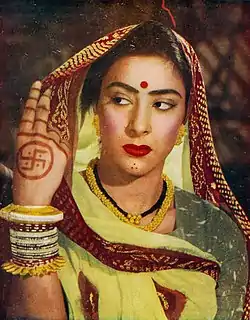 Nargis in Mother India | |
| Born | Fatima Rashid[1] 1 June 1929 |
| Died | 3 May 1981 (aged 51) |
| Resting place | Bada Qabrastan, Marine Lines, Mumbai, Maharashtra, India |
| Nationality | Indian |
| Other names | |
| Occupation | Actress |
| Years active | 1935–1936 1942–1968 |
Notable work | Barsaat (1949) Babul (1950) Awara (1951) Shree 420 (1955) Mother India (1957) Raat Aur Din (1967) |
| Spouse(s) | |
| Children | Sanjay Dutt Priya Dutt Namrata Dutt |
| Parent(s) | |
| Relatives | See Dutt family |
| Awards |
|
| Honours | Padma Shri (1958) |
| Member of Parliament, Rajya Sabha | |
| In office 3 April 1980 – 3 May 1981 (her death) | |
In a career that spanned three decades, Nargis appeared in numerous commercially successful as well as critically acclaimed films, many of which featured her alongside actor Raj Kapoor. She was the younger sister of the well-known actor Anwar Hussain. Her best-known role was that of Radha in the Academy Award-nominated Mother India (1957), a performance that won her the Filmfare Award for Best Actress. She would appear infrequently in films during the 1960s. Some of her films of this period include the drama Raat Aur Din (1967), for which she received the inaugural National Film Award for Best Actress.
Nargis married her Mother India co-star Sunil Dutt in 1958. Together they had three children, including the actor Sanjay Dutt. Along with her husband, Nargis formed the Ajanta Arts Culture Troupe which roped in several leading actors and singers of the time and held stage shows at border areas. In the early 1970s, Nargis became the first patron of The Spastic Society of India and her subsequent work with the organisation brought her recognition as a social worker and later a Rajya Sabha nomination in 1980.
Nargis died in 1981 of pancreatic cancer, only three days before her son Sanjay Dutt made his debut in Hindi films with the film Rocky. In 1982, the Nargis Dutt Memorial Cancer Foundation was established in her memory. The award for Best Feature Film on National Integration in the Annual Film Awards ceremony is called the Nargis Dutt Award in her honour.
Early life and background
Nargis was born as Fatima Rashid in Calcutta, Bengal Presidency, British Indian Empire (now Kolkata, West Bengal, India) in a Punjabi Muslim family. Her father Abdul Rashid, formerly Mohanchand Uttamchand ("Mohan Babu"), was originally a wealthy Punjabi Hindu heir from Rawalpindi, Punjab Province who had converted to Islam.[3][1][5][6] Her mother was Jaddanbai, a Hindustani classical music singer and one of the early pioneers of Indian cinema.[7] Nargis' family then moved from Punjab to Allahabad in Uttar Pradesh. She introduced Nargis into the movie culture unfolding in India at the time. Nargis' maternal half-brother, Anwar Hussain, was also a film actor.
Career
1935-48: Debut and early films
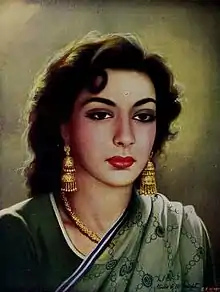
Fatima made her first film appearance in the 1935 film Talashe Haq when she was six years old, credited as Baby Nargis. Nargis (نرگس [ˈnərɡɪs]) is a Persian word meaning Narcissus, the daffodil flower. She was subsequently credited as Nargis in all of her films.[8][9]
Nargis appeared in numerous films after her debut. In 1943 at the age of 14, she appeared in Mehboob Khan's Taqdeer, opposite Motilal.[10] The film was a box office success, and she was extensively praised for her performance. Filmindia referred to it as "an excellent debut".
Following Taqdeer, Nargis starred in the 1945 period drama Humayun, opposite the leading actor of those times, Ashok Kumar. The film was moderately successful. Among her early releases were Mela, Anokha Pyar and Aag all in 1948. The former two starred her with Dilip Kumar and the latter marked her first collaboration with Raj Kapoor. Except Mela, which was among the highest-grossing films of that year, none of her film fared well in 1948.
1949-51: Breakthrough years
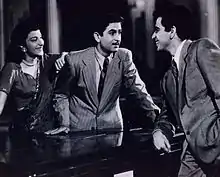
In 1949, Nargis starred in Mehboob Khan's critically acclaimed drama Andaz. The film saw her playing Neena, whose husband Rajan (Raj Kapoor) suspects of her having an affair with her friend Dilip (Dilip Kumar). It had a slow start at the box office, but as soon as positive word-of-mouth spread, it emerged as a major commercial success and the highest-grossing film of all time.[11] The film was first hit in Kapoor's career, and a breakthrough for Nargis and Kumar. After the success of the movie, Kapoor cast her again as a leading lady in his second directorial venture after the unsuccessful Aag (1948).
This venture of Kapoor was released in the same year, starring Nargis as a village belle and him starring as a poet. It was titled Barsaat. The film was the debut of Nimmi, who would later become a well-known actress. Its release was already hyped due to the huge success of Andaz, and therefore it became another major box office success. Barsaat was the highest-grossing film of 1949, as well as of all time, breaking the record of Andaz.[12] This established her as one of the most popular and bankable stars of that era.
Next, Nargis played the lead roles in 1950 films Jogan and Babul, along with Dilip Kumar. Both of them were box-office hits and her performance in Babul was specially noticed.[13]
Due to the success of Andaz and Barsaat, Raj Kapoor was impressed by Nargis' onscreen charm and presence. He therefore chose her to play a character in Awaara (1951) (often written as Awāra). Although it revolved around a father and his estranged son, Nargis played an important role in the movie as a lawyer who knows the truth that Raj (played by Kapoor) and Raghunath (played by Prithviraj Kapoor) are son-father. Unlike the roles played by other actresses of those times, Nargis portrayed an outspoken woman-lawyer who criticises the people who regard woman as a "thing made for household chores". She was also seen donning a swimwear in a scene from Awaara, a quite bold dress for Indian woman to wear in that era. The film was released on 14 December 1951, receiving universal acclaim for the performances of Prithviraj, Raj and Nargis. Not only in India, the film was a blockbuster overseas too, making Nargis and Raj well-known stars in countries such as Greece and USA. Grossing ₹12.5 million in India, it became the highest-grossing film of all time, breaking the record of Barsaat.[14] Deedar, released in the same year was another hit in Nargis' filmography.[15]
1952-54: Career setbacks
Nargis' films released between 1952 and 1954 didn't perform well, neither critically and commercially. In 1952, she had as many as six releases, only Anhonee being a success.[16] 1953 and 1954 saw her doing five films, none of them a box-office hit. However, her 1953 film Aah has gained a cult status over the years.[16]
1955-57: Reigning years
Nargis revived her career with Raj Kapoor's social drama Shree 420 (1955). The film was the highest-grossing film of all time, and featured several popular tracks.
She once again collaborated with Kapoor for the box office success Chori Chori (1956), which revolves around a girl (Nargis) who runs away from her house in order to marry a gold digger pilot (Pran), but ends up falling for a news reporter (Kapoor) whom she meets in a bus. In the same year, she did a special appearance in Kapoor's Jagte Raho. The film was her last to co-star Raj Kapoor.[17]
In 1957, she appeared in Mehboob Khan's Oscar-nominated epic drama Mother India, for which she won the Filmfare Best Actress Award for her performance.[18] Baburao Patel of the film magazine, Filmindia, in December 1957, described Mother India as "the greatest picture produced in India" and wrote that no other actress would have been able to perform the role as well as Nargis.[19][20] Also in 1957, she acted in the Pardesi (marketed as Journey Beyond Three Seas in English), which was an Indo-Soviet co-production.[21]
Films with Raj Kapoor
Nargis and Raj Kapoor acted together in 16 films spanning over a period of 10 years, including Awaara, Shree 420, Jagte Raho (cameo), Andaz, Chori Chori, Aah, Aag and Barsaat. Their first film together was Aag in 1948. Aag was not a commercial success, Aah's earnings were average, but others were commercially successful. Songs from these movies featuring them have grown to become memorable. Some examples are "Barsat mein humse mile" and "Jiya beqarar hai" (in Barsaat); "Dam bhar jo udhar munh phere" and "Ghar aaya mera pardesi" (in Awaara); "Sham gayi raat aayi", "Ichak dana beechak dana" and "Pyar ha ikraar hua" (in Shree 420); and "Pancchi banoon udti phiroon", "Aa ja sanam madhur chandni mein", and "Yeh raat bheegi bheegi" (in Chori Chori).[17] Their work in Awaara made the couple famous internationally,[20] particularly in the Soviet Union, where the film was dubbed in Russian and released as Brodiaga.[22]
1958-67: Later career
.jpg.webp)
After her marriage to Sunil Dutt in 1958, Nargis gave up her film career to settle down with her family, after her last few films were released.[23] She made her last film appearance in the 1967 film Raat Aur Din, being convinced to act after fifteen years.[20] The film was well received and Nargis' performance as a woman who has dissociative identity disorder was critically acclaimed. For this role she won the National Film Award for Best Actress and became the first actress to win in this category.[24] She also received a Filmfare Best Actress Award nomination for this film.
In 2011, Rediff.com listed her as the greatest actress of all time, stating, "An actress with range, style, grace and an incredibly warm screen presence, Nargis is truly a leading lady to celebrate."[25] M.L. Dhawan from The Tribune said, "In almost all her films Nargis created a woman who could be desired and deified. The charisma of Nargis's screen image lay in that it oscillated between the simple and the chic with equal ease."[26] In 2005, Indiatimes Movies wrote: "Whenever Raj Kapoor and Nargis came together on screen, sparks flew. Their chemistry was electrifying and it crackles with raw passion in Raj Kapoor's Awaara. Nargis's wild and carefree sensuality pulsates and Raj Kapoor's scruffy hair-rebellious persona only adds fuel to the fire".[27] Surendra Kumar of The Sunday Guardian stated, "She was a versatile actor who could carry off serious roles, light roles and even comic roles with the same élan. She could be urbane and sophisticated, as in Awaara, Chori Chori and Andaz; simple and ordinary, as in Sri 420; and every inch a traditional village woman, as in Mother India."[20]
She was also nominated to the Rajya Sabha (Upper house of Indian Parliament) from 1980–81[4][28] but due to cancer she fell ill and died during her tenure.[29]
Personal life
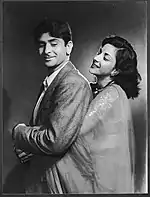
Nargis had a long-time relationship with actor Raj Kapoor, who was her co-star in the films Awaara and Shree 420. Raj Kapoor was married and had children. After he refused to divorce his wife, Nargis ended their nine-year-long relationship.[30][31]
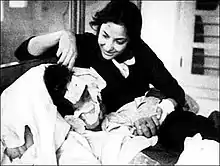
Nargis married actor Sunil Dutt (a Punjabi Hindu from Jhelum district, British India) on 11 March 1958. Reportedly, Dutt had saved her life from a fire on the sets of Mother India.[32] She had also reportedly helped Dutt's sister and mother.[33] They married on 11 March 1958.[34] She converted to Hinduism on her marriage.[35] They had three children: Sanjay, Namrata, and Priya.
Sanjay went on to become a successful film actor. Namrata married actor Kumar Gaurav, son of veteran actor Rajendra Kumar who had appeared alongside Nargis and Sunil Dutt in Mother India. Priya became a politician and a Member of Parliament (Lok Sabha).[32]
With her husband, Nargis formed the Ajanta Arts Cultural Troupe, which involved several leading actors and singers of the time, and performed at remote frontiers to entertain the Indian soldiers at border. It was the first troupe to perform in Dhaka, after the liberation war of Bangladesh in 1971. Later, Nargis worked for the cause of spastic children. She became the first patron of the Spastics Society of India. Her charitable work for the organisation got her recognition as a social worker.[33]
Nargis loved wearing white saris, speaking over the telephone and eating panipuris sold on the streets. She was an excellent swimmer and enjoyed playing cricket with her brothers.[23] The founder of the Spastic Society of India, Mithu Alur, stated in an interview that Nargis had a dream of pursuing medicine that she could never fulfill.[36]
Illness and death
On 2 August 1980, Nargis fell ill during a session of the Rajya Sabha, with the initial cause assumed to be jaundice. She was rushed home and admitted to Breach Candy Hospital in Bombay. After fifteen days of tests, during which her condition kept worsening and she rapidly lost weight, she was diagnosed with pancreatic cancer in 1980 and underwent treatment for the disease at Memorial Sloan-Kettering Cancer Center in New York City.[37][38] Upon her return to India, her condition deteriorated and she was admitted at Breach Candy Hospital. Nargis went into a coma on 2 May 1981 after she became seriously ill and died the next day. She was buried at Badakabarastan in Marine Lines, Mumbai. On 7 May 1981, at the premiere of her son's debut film Rocky, one seat was kept vacant for her.[32]
One year after her death, the Nargis Dutt Memorial Cancer Foundation was established by Sunil Dutt in her memory.[39] Though Nargis' death was widely attributed to cancer, her daughter Namrata shared that she had successfully fought the pancreatic cancer but died from a urinary tract infection. Her son Sanjay added that her lowered immunity levels made her susceptible to the infection.[40][41]
Legacy
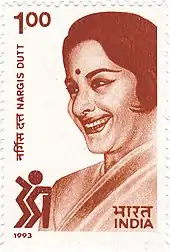
A scene from the 1949 film Barsaat, featuring Raj Kapoor holding Nargis in one arm and a violin in the other, was chosen as the basis of the logo of R. K. Films.[20][42]
Multiple books were written about Nargis. The first was written in 1994 by T. J. S. George and was titled The Life and Times of Nargis.[43] In 2007, Nargis' daughters Priya and Namrata published a book about the lives of their parents, titled, Mr. and Mrs. Dutt: Memories of our Parents.[44][45][46] Also that year, Darlingji: The True Love Story of Nargis and Sunil Dutt was released by Kishwar Desai.[47][48]
Nargis was played by actress Manisha Koirala in the 2018 film Sanju, the biopic of her son, Sanjay Dutt. The film is ranked as one of the highest grossing Indian films of 2018.[49][50] Feryna Wazheir portrayed her in the 2018 film Manto.[51][52]
Awards and recognitions
- 1958 – Filmfare Best Actress Award for Mother India[53]
- 1958 – She was the first film actress to conferred by the Government of India with the Padma Shri title, the fourth highest civilian award.[10]
- 1958 – Best Actress Award[54] at the Karlovy Vary International Film Festival for Mother India
- 1968 – National Film Award for Best Actress for Raat Aur Din.[10]
- 1969 – Nominated, Filmfare Best Actress Award for Raat Aur Din
- 2001 – "Best Artists of the Millennium" award by Hero Honda and film magazine Stardust along with actor Amitabh Bachchan.[55]
A street in Bandra, Mumbai, is named Nargis Dutt Road in her memory.[56] A postal stamp of face value 100 paise was issued by India Post was issued in Nargis' honour on 30 December 1993.[57] Google celebrated Nargis Dutt on her 86th birthday on 1 June 2015.[58]
The National Film Awards honoured Dutt by instituting the Nargis Dutt Award for Best Feature Film on National Integration upon her achievement in Hindi Cinema.[59]
Filmography
References
- T. J. S. George (December 1994). The life and times of Nargis. Megatechnics. ISBN 978-81-7223-149-1. Retrieved 8 March 2012.
- "Why Nargis said 'Meena, Maut Mubarak Ho!'". The Times of India. 2 December 2018. Retrieved 2 December 2018.
- "Bollywood actor Nargis Dutt remembered in today's Google Doodle". The Indian Express. 1 June 2015.
- "Archived copy". Archived from the original on 1 May 2009. Retrieved 19 May 2009.CS1 maint: archived copy as title (link)
- Parama Roy (6 September 1998). Indian traffic: identities in question in colonial and postcolonial India. University of California Press. p. 156. ISBN 978-0-520-20487-4. Retrieved 8 March 2012.
- Shyam Bhatia (20 October 2003). "Nargis-Sunil Dutt: A real life romance". Rediff. Retrieved 3 June 2012.
- "India's Independent Weekly News Magazine". Tehelka. Archived from the original on 5 April 2012. Retrieved 12 July 2012.
- "Nargis Dutt's 86th Birth Anniversary: 10 things you would want to know about beautiful Nargis". India.com. 1 June 2015. Retrieved 8 August 2020.
- "Nargis". Mint. 4 May 2013.
- "Archived copy". Archived from the original on 10 February 2007. Retrieved 17 January 2007.CS1 maint: archived copy as title (link)
- Raheja, Dinesh (14 March 2002). "Classics Revisited: Andaz". Rediff.com. Retrieved 8 August 2020.
- Gupta, Trisha (25 August 2019). "A love for all seasons". Mumbai Mirror. Retrieved 8 August 2020.
- Verma, Sukanya (4 December 2014). "Classic Revisited: Dilip Kumar-Nargis' grace in Jogan". Rediff. Retrieved 8 August 2020.
- Rao, Soumya (13 July 2019). "Raj Kapoor-Nargis to Deepika-Ranbir: A survey ranks the most popular Bollywood couples". Scroll.in. Retrieved 8 August 2020.
- Farook, Farhana (11 December 2019). "Birthday Special: Romance icon Dilip Kumar's most famous on-screen pairings". Filmfare. Retrieved 8 August 2020.
- Mishra, Nivedita (1 June 2020). "On Nargis' 91st birth anniversary, a look at a star who symbolised passion onscreen". Hindustan Times. Retrieved 8 August 2020.
- Bhowal, Tiasa (27 June 2018). "For Sanjay Dutt, Sanju Actress Buys Original Mother India Poster, Featuring Nargis". NDTV.com. Retrieved 8 August 2020.
- Mishra, Vijay (2002). Bollywood Cinema: Temples of Desire. Routledge. p. 65. ISBN 978-0-415-93015-4.
- Kumar, Surendra (12 May 2018). "There hasn't been a better actress in India than Nargis". The Sunday Guardian Live. Retrieved 8 August 2020.
- Thompson, Howard (11 April 1960). "Screen: Adventure Story:' Journey Beyond Three Seas' at the Cameo". The New York Times. ISSN 0362-4331. Retrieved 8 August 2020.
- Bhatia, Sidharth (6 July 2015). "From Socialism to Disco Dance, How Bollywood Made Its Mark in Russia, Central Asia". The Wire. Retrieved 8 August 2020.
- "On Nargis's 39th death anniversary, here are some lesser-known facts about the legendary actor". Hindustan Times. 3 May 2020. Retrieved 8 August 2020.
- Sood, Samira (9 May 2020). "Raat Aur Din, directed by Satyen Bose, was the perfect swansong for Nargis". ThePrint. Retrieved 8 August 2020.
- Sen, Raja (29 June 2011). "Readers Choice: The Greatest Actresses of all time". Rediff.com. Retrieved 19 September 2011.
- Dhawan, M.L. (9 December 2007). "Queens of hearts". The Tribune. Retrieved 22 September 2011.
- Kanwar, Rachna (3 October 2005). "25 Must See Bollywood Movies". India Times. Archived from the original on 16 May 2008. Retrieved 27 May 2008.
- "Maharashtra govt in peril, governance takes backseat". Screenindia.com. Archived from the original on 1 January 2007. Retrieved 30 July 2017.
- "Nargis: A daughter remembers". Rediff.com. Retrieved 30 July 2017.
- Patel, Bhaichand (19 November 2007). "Clangorous Liaisons". Outlook. Retrieved 2 June 2015.
- Roy, Gitanjali (17 January 2017). "Rishi Kapoor Reveals Dad Raj Kapoor's Alleged Affairs With His Heroines". NDTV Movies. Retrieved 30 July 2017.
- Dhawan, M.L. (27 April 2003). "A paean to Mother India". The Tribune. Retrieved 7 September 2008.
- "Dauntless Dutt". The Tribune. 29 May 2004. Retrieved 30 July 2017.
- "Other side of Love Jihad". Siasat. 20 October 2016.
- "Conversions: Famous personalities who converted, and some who almost did". The Economic Times. 5 January 2015. Retrieved 5 February 2020.
- Krishnankutty, Pia (3 May 2020). "An actor, mother, social worker - Nargis Dutt was far more than Mother India". ThePrint. Retrieved 8 August 2020.
- Usman, Yasser (2018). Sanjay Dutt: The Crazy Untold Story of Bollywood's Bad Boy. Juggernaut Books. p. 50. ISBN 978-93-86228-58-1.
- Somaaya, Bhawana (25 May 2017). "Nargis and Sunil Dutt: A Love Story In the House of Heartbreaks". TheQuint. Retrieved 8 August 2020.
- Pais, Arthur J (15 September 2009). "Will Sanjay Dutt's daughter carry on the legacy?". Rediff. Retrieved 8 August 2020.
- "Nargis and Sunil Dutt's love story is nothing less than a fairytale romance!". Free Press Journal. 1 June 2018.
- "Sanju negative". The Pioneer. 24 March 2013. Retrieved 8 August 2020.
- "Was It a Painting That Inspired the Iconic RK Studio Logo?". TheQuint. 27 August 2018. Retrieved 8 August 2020.
- Kidwai, Rasheed (9 July 2018). "Reel vs real: The politics behind the life and crimes of Sanjay Dutt". Business Standard India. Retrieved 14 August 2020.
- "To Mr. and Mrs. Dutt, with love". The Hindu. 7 October 2007. Archived from the original on 11 October 2007. Retrieved 14 August 2020.
- Misra, Neelesh (27 September 2007). "My father was let down, he was a lone warrior: Priya". Hindustan Times. Retrieved 14 August 2020.
- "A family's life story, touchingly told". Business Standard India. 30 September 2007. Retrieved 14 August 2020.
- Salil, Kuldip (17 November 2007). "Brought Back to Life". Telegraph India. Retrieved 14 August 2020.
- "Book reveals true love story of Nargis and Sunil Dutt". The Times of India. PTI. 28 October 2007. Retrieved 14 August 2020.
- "Sanjay Dutt biopic: Manisha Koirala looks like a perfect replica of Nargis Dutt – Most talked about biopics you just cannot miss". The Times of India.
- "Manisha Koirala Is Bang on as Nargis in Sanjay Dutt Biopic". 5 January 2018.
- Dubey, Rachana (28 March 2017). "Feryna Wazheir to play Nargis in 'Manto'". The Times of India. Retrieved 8 August 2020.
- Lohana, Avinash (11 April 2017). "Feryna Wazheir to portray young Nargis Dutt in Nandita Das's Manto". Mumbai Mirror. Retrieved 14 December 2018.
- "Filmfare Awards Winners From 1953 to 2018". Filmfare Awards. Retrieved 30 May 2018.
- 1958 awards at the official site
- "The Tribune, Chandigarh, India – Nation". The Tribune. Retrieved 2 June 2015.
- Singh, Varun (25 December 2017). "Priya Dutt's Bandra flat sets real estate record". DNA India. Retrieved 8 August 2020.
- "Nargis Dutt". Indian Philately. Thakkar Numismatic & Art Foundation. Retrieved 30 May 2018.
- "Google Doodle celebrates Nargis' 86th birthday". The Hindu. 1 June 2015. Retrieved 8 August 2020.
- "An award in a different genre". The Hindu. 7 January 2005. p. 2. Retrieved 30 July 2017.
External links
| Wikimedia Commons has media related to Nargis (actress). |
- Nargis at IMDb
- "Remembering Nargis Dutt: Rare photos of the Mother India actor". The Indian Express. 3 May 2019.
- Nargis on YouTube - 1991 documentary directed by Priya Dutt and produced by Films Division of India
- "Sunil Dutt, Nargis: a romance that rose from ashes". NDTV. 5 October 2012. Archived from the original on 31 March 2013.
Further reading
- George, T. J. S. (1994). The Life and Times of Nargis. Harper Collins. ISBN 978-81-7223-149-1.
- Desai, Kishwar (2007). Darlingji : The True Love Story Of Nargis and Sunil Dutt. HarperCollins Publishers India. ISBN 978-81-7223-697-7.
- Dutt Kumar, Namrata; Dutt, Priya (2007). Mr. and Mrs. Dutt: Memories of Our Parents. Roli Books. ISBN 978-81-7436-455-5.
- Dwyer, Rachel (2013). Fire and Rain, The Tramp and The Trickster: romance and the family in the early films of Raj Kapoor (PDF). The South Asianist Journal (Report). 2. Centre for South Asian Studies, University of Edinburgh. ISSN 2050-487X.